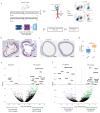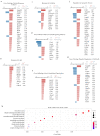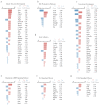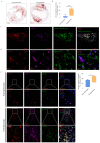Single-Cell Analysis Uncovers Osteoblast Factor Growth Differentiation Factor 10 as Mediator of Vascular Smooth Muscle Cell Phenotypic Modulation Associated with Plaque Rupture in Human Carotid Artery Disease
- PMID: 35163719
- PMCID: PMC8836240
- DOI: 10.3390/ijms23031796
Single-Cell Analysis Uncovers Osteoblast Factor Growth Differentiation Factor 10 as Mediator of Vascular Smooth Muscle Cell Phenotypic Modulation Associated with Plaque Rupture in Human Carotid Artery Disease
Abstract
(1) Background: Vascular smooth muscle cells (VSMCs) undergo a complex phenotypic switch in response to atherosclerosis environmental triggers, contributing to atherosclerosis disease progression. However, the complex heterogeneity of VSMCs and how VSMC dedifferentiation affects human carotid artery disease (CAD) risk has not been clearly established. (2) Method: A single-cell RNA sequencing analysis of CD45- cells derived from the atherosclerotic aorta of Apolipoprotein E-deficient (Apoe-/-) mice on a normal cholesterol diet (NCD) or a high cholesterol diet (HCD), respecting the site-specific predisposition to atherosclerosis was performed. Growth Differentiation Factor 10 (GDF10) role in VSMCs phenotypic switch was investigated via flow cytometry, immunofluorescence in human atherosclerotic plaques. (3) Results: scRNAseq analysis revealed the transcriptomic profile of seven clusters, five of which showed disease-relevant gene signature of VSMC macrophagic calcific phenotype, VSMC mesenchymal chondrogenic phenotype, VSMC inflammatory and fibro-phenotype and VSMC inflammatory phenotype. Osteoblast factor GDF10 involved in ossification and osteoblast differentiation emerged as a hallmark of VSMCs undergoing phenotypic switch. Under hypercholesteremia, GDF10 triggered VSMC osteogenic switch in vitro. The abundance of GDF10 expressing osteogenic-like VSMCs cells was linked to the occurrence of carotid artery disease (CAD) events. (4) Conclusions: Taken together, these results provide evidence about GDF10-mediated VSMC osteogenic switch, with a likely detrimental role in atherosclerotic plaque stability.
Keywords: atherosclerosis; carotid artery disease; vascular smooth muscle cells.
Conflict of interest statement
The authors declare no conflict of interest.
Figures










Similar articles
-
Single-Cell RNA-Seq Reveals a Crosstalk between Hyaluronan Receptor LYVE-1-Expressing Macrophages and Vascular Smooth Muscle Cells.Cells. 2022 Jan 25;11(3):411. doi: 10.3390/cells11030411. Cells. 2022. PMID: 35159221 Free PMC article.
-
NLRP3 Inflammasome Activation Controls Vascular Smooth Muscle Cells Phenotypic Switch in Atherosclerosis.Int J Mol Sci. 2021 Dec 29;23(1):340. doi: 10.3390/ijms23010340. Int J Mol Sci. 2021. PMID: 35008765 Free PMC article.
-
Membrane-Tethered Metalloproteinase Expressed by Vascular Smooth Muscle Cells Limits the Progression of Proliferative Atherosclerotic Lesions.J Am Heart Assoc. 2017 Jul 22;6(7):e003693. doi: 10.1161/JAHA.116.003693. J Am Heart Assoc. 2017. PMID: 28735290 Free PMC article.
-
Six Shades of Vascular Smooth Muscle Cells Illuminated by KLF4 (Krüppel-Like Factor 4).Arterioscler Thromb Vasc Biol. 2021 Nov;41(11):2693-2707. doi: 10.1161/ATVBAHA.121.316600. Epub 2021 Sep 2. Arterioscler Thromb Vasc Biol. 2021. PMID: 34470477 Free PMC article. Review.
-
Vascular Smooth Muscle Cells in Atherosclerosis.Circ Res. 2016 Feb 19;118(4):692-702. doi: 10.1161/CIRCRESAHA.115.306361. Circ Res. 2016. PMID: 26892967 Free PMC article. Review.
Cited by
-
GDF10 is a negative regulator of vascular calcification.J Biol Chem. 2024 Nov;300(11):107805. doi: 10.1016/j.jbc.2024.107805. Epub 2024 Sep 21. J Biol Chem. 2024. PMID: 39307303 Free PMC article.
-
Next-Generation and Single-Cell Sequencing Approaches to Study Atherosclerosis and Vascular Inflammation Pathophysiology: A Systematic Review.Front Cardiovasc Med. 2022 Mar 28;9:849675. doi: 10.3389/fcvm.2022.849675. eCollection 2022. Front Cardiovasc Med. 2022. PMID: 35419441 Free PMC article.
-
Single-Cell Landscape and a Macrophage Subset Enhancing Brown Adipocyte Function in Diabetes.Diabetes Metab J. 2024 Sep;48(5):885-900. doi: 10.4093/dmj.2023.0278. Epub 2024 May 29. Diabetes Metab J. 2024. PMID: 38853519 Free PMC article.
-
Clinical implications of inflammation in atheroma formation and novel therapies in cardiovascular diseases.Front Cell Dev Biol. 2023 Mar 16;11:1148768. doi: 10.3389/fcell.2023.1148768. eCollection 2023. Front Cell Dev Biol. 2023. PMID: 37009489 Free PMC article. Review.
-
Strategies for arterial graft optimization at the single-cell level.Nat Cardiovasc Res. 2024 May;3(5):541-557. doi: 10.1038/s44161-024-00464-6. Epub 2024 Apr 25. Nat Cardiovasc Res. 2024. PMID: 39195932
References
-
- Mozaffarian D., Benjamin E.J., Go A.S., Arnett D.K., Blaha M.J., Cushman M., Das S.R., de Ferranti S., Despres J.P., Fullerton H.J., et al. Heart Disease and Stroke Statistics—2016 Update: A Report From the American Heart Association. Circulation. 2016;133:e38–e360. doi: 10.1161/CIR.0000000000000350. - DOI - PubMed
-
- Pfaltzgraff E.R., Shelton E.L., Galindo C.L., Nelms B.L., Hooper C.W., Poole S.D., Labosky P.A., Bader D.M., Reese J. Embryonic domains of the aorta derived from diverse origins exhibit distinct properties that converge into a common phenotype in the adult. J. Mol. Cell Cardiol. 2014;69:88–96. doi: 10.1016/j.yjmcc.2014.01.016. - DOI - PMC - PubMed
MeSH terms
Substances
Grants and funding
LinkOut - more resources
Full Text Sources
Medical
Molecular Biology Databases
Research Materials
Miscellaneous

